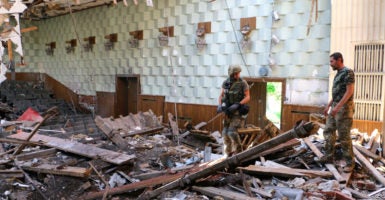KYIV, Ukraine—You can’t fake courage in a trench war.
The thing is, there’s no escaping the danger. You could die just as easily while walking to the toilet as you could while holding the line under artillery fire. You never know when the shelling will start, or when a sniper has you in his sights.
In the end, your chances of survival usually just depend on good luck and the odds of not being in the wrong place at the wrong time. As the saying goes—it’s better to be lucky than good.
After more than five years of constant combat in their country’s embattled, eastern Donbas region, some Ukrainian soldiers have learned to simply laugh at the danger and treat the war like a sport. Others grow quiet and gloomy, imagining at every moment how they could die.
“Nobody will feel safe while Russia is waging war against Ukraine in the center of Europe,” Ukrainian President Volodymyr Zelenskyy said Wednesday in a speech before the United Nations General Assembly.
An unfolding uproar over a phone conversation two months ago between Zelenskyy and President Donald Trump suddenly has put Ukraine and its 5-year-old resistance of Russian aggression in the foreground of the political landscape.
In Ukraine, some exceptional soldiers are able to see the war for the tragedy it truly is and go on fighting anyway.
In the summer of 2015, while embedded with the Ukrainian regular army in the front-line village of Pisky, I befriended a young soldier named Daniel Kasyanenko who was among this rare breed.
He was only 19, but Daniel had an uncanny ability to put the war in perspective. He understood the toll that combat was taking on his young soul and recognized the war was not black and white.
Yet, Daniel never failed to pull the trigger when he had to. Consequently, the things he had done and seen in war haunted him. He told me the war had “ruined him” and his “understanding of life.” It would have been better to go to war as an old man, he confided.
When I departed the front lines, Daniel and I pledged to stay in touch. We talked about the possibility of his coming to America one day, which was his dream. But a few days after I’d returned to Kyiv, I received a somewhat disjointed text message from Daniel.
He’d been injured by a mortar, he told me, and had what the Ukrainian medics called a “brain contusion,” which probably meant he had a concussion, or, more likely, a traumatic brain injury. In any case, Daniel’s commanders gave him a few weeks’ leave to go back to his hometown of Zaporizhia, only a three-hour car ride from the front lines.
Daniel spent a couple of weeks at home, living with his parents, Marina and Konstantin Kasyanenko. It was a tough time for Daniel’s parents as they tried, over and over, to convince their son that he didn’t have to go back to war.
And the truth is, he didn’t.
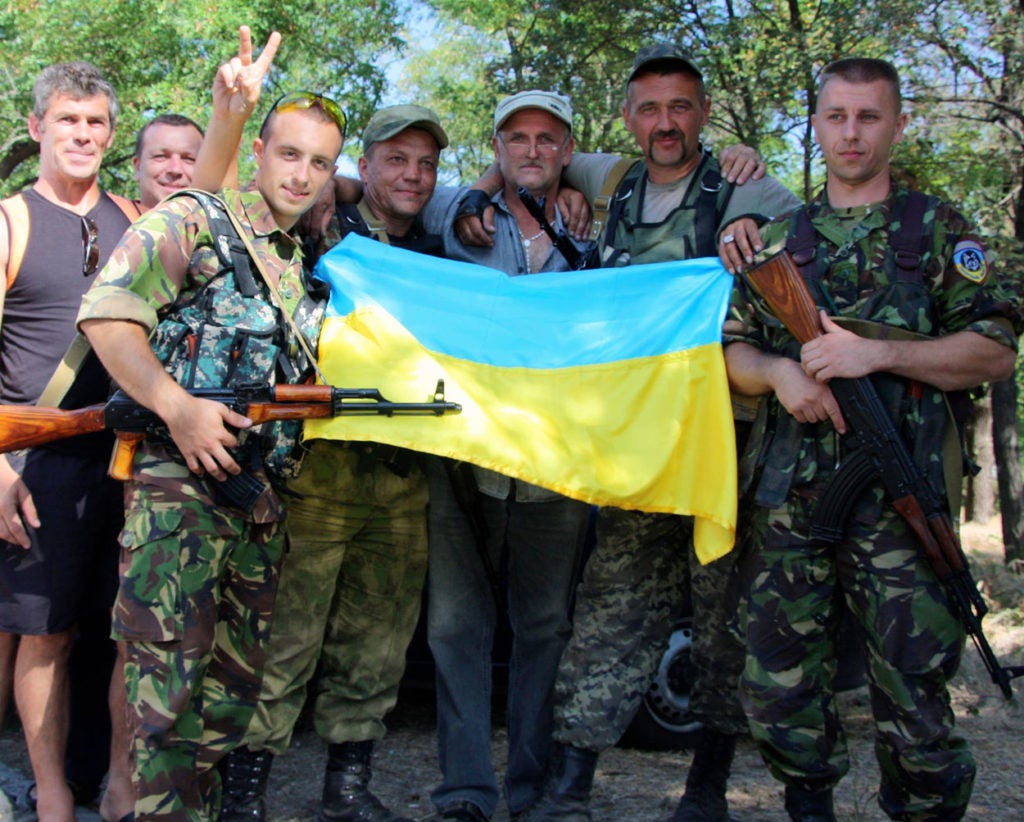
You see, when Russia invaded Ukraine in the summer of 2014, Daniel, like so many Ukrainians of his generation, simply headed for the front and joined the ranks of an irregular militia that had formed to fight the Russian invasion.
These volunteers learned how to be soldiers while in the war, with no formal training. They jokingly called it “natural selection” training.
Daniel, for his part, went straight from living under his parents’ roof to living under Russian artillery and sniper fire. There was no chance for him to become a man before he became a soldier.
Marina Kasyanenko later told me that she would watch her son sleeping while he was home on convalescent leave. He’d changed so much in the few months he’d been away, she remembered.
“He went to war as a boy and came back as a wise old man,” she said.
On the day he left to go back to war, Marina begged her son to stay. “You’re too young,” she told him.
“Mom, I have to go back,” Daniel answered. “I have to go back to my friends. It’s my duty.”
He did. And two weeks later, a mortar killed Daniel during a battle in Pisky.
As I said, he was just 19.
Since Daniel’s death, my wife, Lilly, and I took a trip down to Zaporizhia to meet his parents. I asked Marina if it was OK for me to use her words as a way to tell people about the war, and to help explain what her son had died fighting for.
She replied: “You do what you can to prevent our boys from dying. The whole world must learn the truth about the war in Ukraine.”
So, here it is. Here’s the truth.
The war in Ukraine is not a civil war. It never was. It always has been, and it remains, a Russian invasion.
A Secret
Today, Ukraine is square in the middle of a political firestorm in Washington, D.C.
It’s a bit ironic, and tragic, I must admit, that after more than five years of reporting on the war in Ukraine, it takes a political controversy in Washington to finally draw U.S. media attention to a country in which Europe’s only ongoing land war is being fought.
In Ukraine, I’ve experienced firsthand a type of combat that exceeded in intensity anything I experienced in Iraq and Afghanistan—both as a U.S. Air Force special operations pilot and while on the ground as a war correspondent in those conflicts.
Rocket attacks, heavy artillery, trench warfare, a civilian airliner shot down by a surface-to-air missile—the war in Ukraine is terrifying.
In September 2014, for instance, I watched a tank battle from a hilltop in the coastal city of Mariupol. Yes, a tank battle. In Europe, in our time. It was like something out of a Hollywood movie. Except it wasn’t. It was for real.
The next day, I toured that battlefield. It was Sept. 5, 2014, the day the war’s first cease-fire was signed.
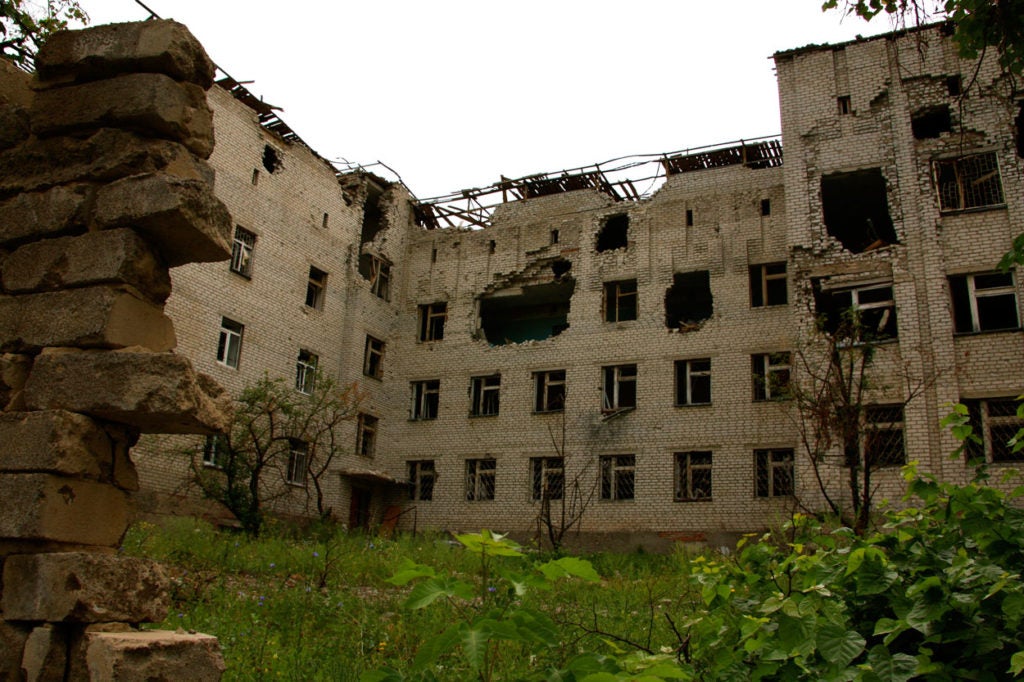
What I saw was a wasteland of destroyed tanks and armored personnel carriers. And lots of dead soldiers, too; their charred, ruined bodies scattered on the ground, frozen in the moments of their deaths like the plaster molds of the dead at Pompeii.
I’d never seen a war like that. But what was even more shocking was that it all felt like a secret. And it still does.
Today, dear reader, as you read these words, Ukrainian troops remain entrenched along a 250-mile-long front line in Ukraine’s eastern Donbas region. There, Ukraine’s military continues to fight a static, trench war against a combined force of pro-Russian separatists, foreign mercenaries, and Russian regulars.
One Ukrainian soldier still dies in combat every three days. And civilians are still dying, too. So far, the war has killed more than 13,000 Ukrainians—roughly half that number died after the Minsk II cease-fire went into effect in February 2015.
And with 1.7 million people who still can’t go home due to the conflict, Europe’s only ongoing land war is also the Continent’s biggest humanitarian crisis.
‘Bad News Bears’ of War
The Ukraine conflict began on April 6, 2014, when Russian security agents and Spetsnaz (special forces) troops engineered an uprising that spawned two Russian-backed territories in eastern Ukraine—the Donetsk People’s Republic, or DNR, and the Luhansk People’s Republic, or LNR.
It was a textbook execution of Russia’s hybrid warfare playbook, blending conventional military force with weaponized propaganda and cyberattacks to create confusion, both on the battlefield and deep within an adversary’s home turf.
The preceding February, Ukrainian protesters had braved snipers on Kyiv’s central square during a revolution to overthrow Viktor Yanukovych, the country’s pro-Russian president. At its heart, Ukraine’s 2014 “Revolution of Dignity” was about the country turning away from Russia and its Soviet past, and looking forward to a pro-Western, pro-democratic future.
Yet Russia painted the revolution as a CIA-orchestrated putsch to install a fascist, pro-American government in Kyiv. The Kremlin spun its 2014 seizure of Crimea and the ensuing conflict in the Donbas as grassroots uprisings created and led by disaffected, Russian-speaking Ukrainians who believed the new government in Kyiv was illegitimate.
In the summer of 2014, the combined Russian-separatist army was on the march in eastern Ukraine. There were worries then that Ukraine could be split in two, or that Russia might launch a large-scale invasion. At that time, Ukraine’s regular army had been depleted by decades of corruption and was able to field only about 6,000 combat-ready soldiers.
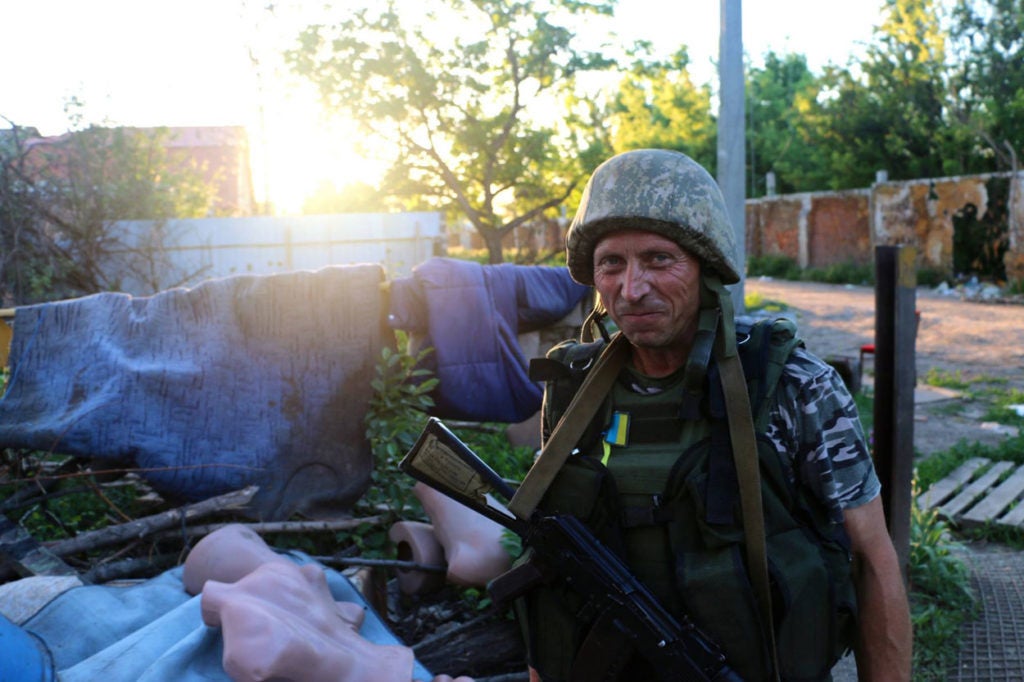
Officials advised citizens in Kyiv to use the city’s metro in case of a Russian aerial bombardment or artillery blitz. In cities across Ukraine, spray-painted signs on the sides of buildings pointed to the nearest bomb shelters.
In those early months of the war, with Ukraine’s regular army on its heels, everyday Ukrainians filled the ranks of irregular, civilian combat units. Meanwhile, legions of volunteers collected and delivered supplies to support the front-line troops—often at great risk.
It was a grassroots war effort, underscoring a widespread attitude of self-reliance among Ukrainian citizens who were unwilling to wait for the government to act in a moment of crisis.
By July 2014, Ukraine’s ragtag armed forces (the “Bad News Bears” of war, as I call them) had retaken 23 out of the 36 districts previously under combined Russian-separatist control. With its troops on the march, it looked briefly like Kyiv might be able to take back all the territory it previously had lost to Russia’s proxies.
But then, in August that year, Russia sent into the conflict thousands of its own troops along with weapons and military hardware. Many Ukrainians feared a full-scale Russian invasion was in the works; a sack of the port city of Mariupol looked imminent.
The September 2014 cease-fire arrested the war from escalating to truly catastrophic levels. However, that first cease-fire quickly collapsed. The subsequent, Minsk II cease-fire ultimately froze the conflict along its current front lines.
But the war never ended.
Deadly Stalemate
The status quo stalemate along the trench lines in eastern Ukraine has developed into a volatile standoff. It’s become a long-range battle mainly fought with indirect fire weapons such as mortars and artillery. For the most part, soldiers hardly ever see at whom they’re shooting. Except for the snipers.
I always thought the threat of snipers was the most terrifying part of this war, or any other I’ve covered. Unlike the arbitrary, haphazard threat of artillery, when a sniper shoots at you it’s personal. Someone is specifically looking through a scope, trying to kill you. It’s a very intimate threat.
At some places along Ukraine’s eastern front, no man’s land can be several miles wide. At others, the Ukrainians and their enemies are close enough to shout insults at one another.
In the front-line town of Shyrokyne in 2015, for example, I was on hand when the Ukrainians’ enemies crawled up to their lines in the night and challenged Ukrainian troops to single, unarmed combat.
Altogether, it’s a bizarre conflict, blending modern technology such as drones and electronic warfare with battlefield conditions similar to those of the World War I trenches—albeit, on a much smaller scale.
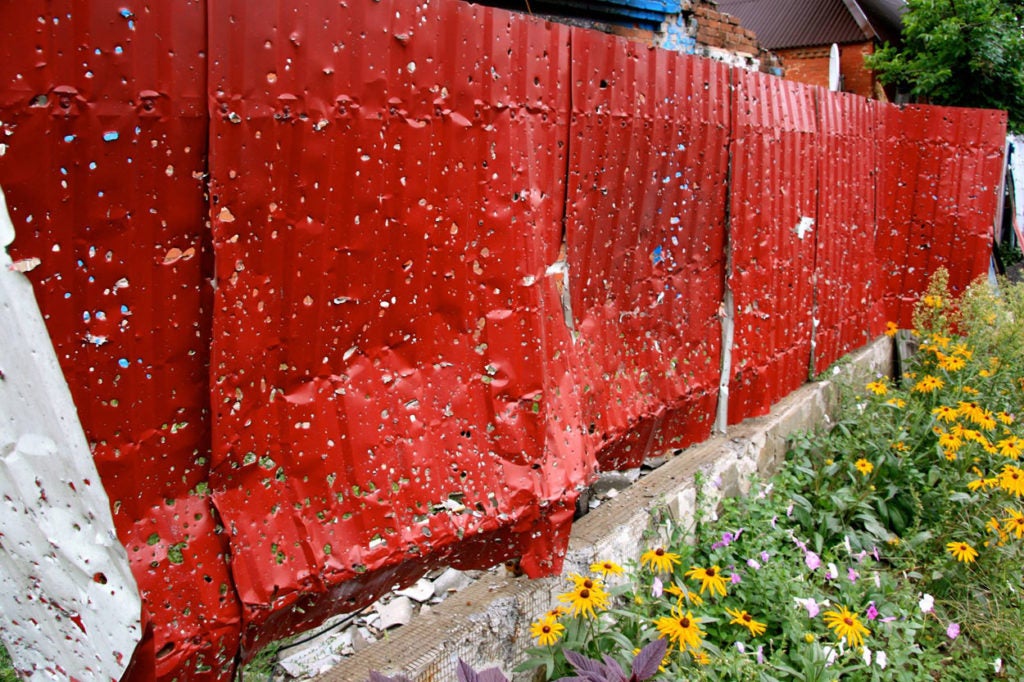
When not in the trenches, the Ukrainian troops usually live in the basements of abandoned homes. It’s simply too dangerous to spend much time above ground with the constant shelling and sniper fire.
An artillery war is, above all, an emotionally exhausting type of combat. Every second, in the back of your mind, you’re worried about dying.
And that constant background din of danger was far different than what I experienced on deployments to Iraq and Afghanistan as an Air Force pilot, in which I had relatively safe places to return to and decompress between missions.
Thus, one major challenge for the U.S. military in a conflict with a near-peer adversary such as Russia is that we might not have those safe redoubts to which we’ve grown accustomed any more.
Russia has the means to attack U.S. bases in ways insurgent forces in Iraq and Afghanistan never could. American troops simply are not used to living with the kind of constant, unending danger that Ukrainian soldiers have faced in the Donbas war zone’s trenches for more than five years.
‘A Dark Comedy’
Since 2014, Russia has used Ukraine as a testing ground for both its modern conventional and hybrid warfare doctrines, providing a case study for the new kinds of security threats the U.S. and its Western allies can anticipate from so-called near-peer adversaries such as Russia and China.
For that reason, U.S. military aid to Ukraine is not a one-way street. In fact, as U.S. armed forces prepare for a new era of threats and great power competition, they stand to learn a lot from Ukraine’s military.
“It’s a great primer for us to see how Russia is fighting in Ukraine,” U.S. Army Col. Lawrence Ferguson, 10th Special Forces Group commander, told me during an exercise in Poland last year.
“We’ve got a good picture of how they’re going to fight,” Ferguson said. “It’s a standard application of force from the USSR, with modern technology.”
With all the hardships they face, Ukraine’s soldiers have learned to adapt. War has become their way of life. The same goes for those Ukrainian civilians left living within the war zone.
It always amazes me how life goes on in spite of the war. Children still attend school, even amid the daily shelling. Shops and grocery stores remain open. Families still gather together for dinner. In Mariupol, a restaurant run by veterans delivers pizzas to soldiers on the front lines.
One of the most striking examples of this coexistence of normal life with the war was in the front-line town of Lobacheve. A river divides the town, and when I last visited, Ukrainians controlled one side while combined Russian-separatist forces controlled the other.
But there was only one school in town. So, each day, the opposing camps agreed to two short cease-fires during which time the town’s children could take a ferry across the river, going to and from school.
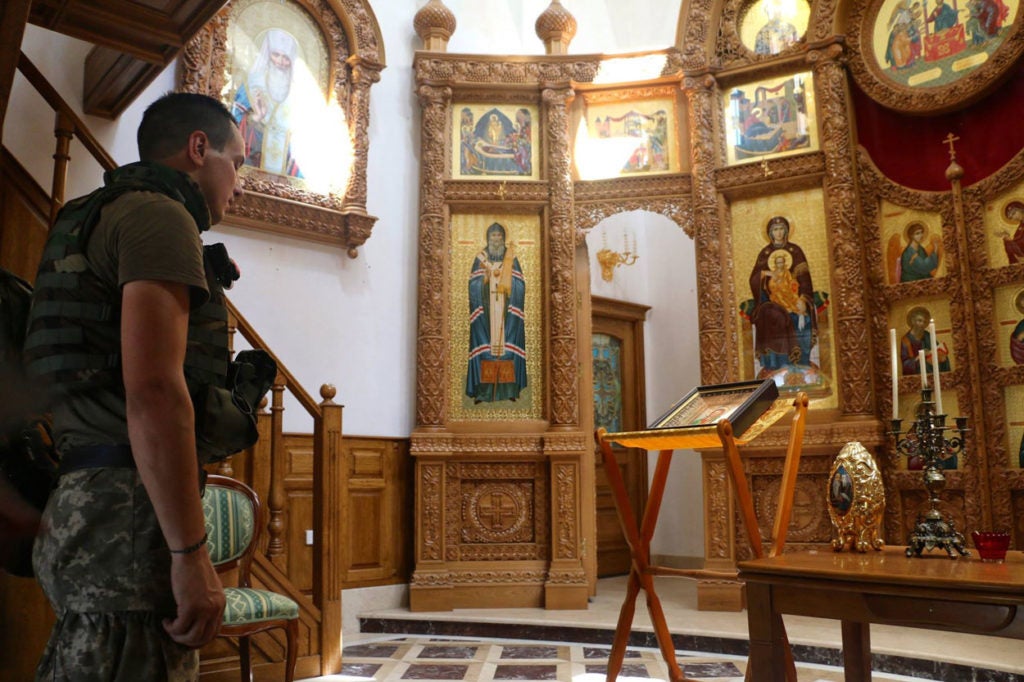
I witnessed one of these bizarre, brief timeouts from the war. It was surreal to watch Ukrainian soldiers casually standing on the riverbank, smoking cigarettes as they waved to their enemies on the other shore.
However, when the truce was over, the snipers came back out, and the soldiers took cover. Like after a water break during a pick-up basketball game, the war was back on.
“War is a dark comedy,” a Ukrainian soldier named Andriy told me with an ironic chuckle as we scrambled for safety.
There’s obviously no love lost between the two camps—even though many Ukrainians have family in Russia and vice versa. In fact, many older Ukrainian soldiers served in the Red Army alongside Russians during the Soviet era. I’ve observed some Ukrainian troops sending Facebook messages to their enemies, who they knew from university or from growing up.
“It’s difficult to make war when the enemy speaks the same language, and they have the same religion,” said Ukrainian soldier and Red Army veteran Oleksandr Derevyanko, 54. “But we have to fight this war, we have no choice. Russia attacked us, and we have to defend our motherland.”
Derevyanko fought in Afghanistan as a Soviet soldier in the 1980s. As is often common among Ukraine’s older soldiers, Derevyanko and I found common ground in our shared recollections of that distant battlefield and what it taught us about war.
“In Afghanistan, I learned that it’s easy to start a war, but hard to finish one,” the old soldier told me.
I couldn’t have said it better.
Sword of Damocles
For Ukraine, the Donbas war remains an existential threat because it could, at any moment, spiral into something much worse. There’s always the chance for an unanticipated escalation. A so-called Franz Ferdinand scenario, as I call it.
Ukraine and Russia have Europe’s two biggest standing land armies in terms of manpower. And they’re shooting at each other every day.
That tenuous status quo has sent shockwaves across Eastern Europe, spurring many countries to prepare for a bigger war. Consequently, the entire military balance of power in Eastern Europe has been upheaved since Russia attacked Ukraine in 2014.
Today, the three Baltic countries of Estonia, Latvia, and Lithuania are among the most rapidly militarizing countries on earth, based on defense spending increases. And Poland has dramatically increased its military spending, too.
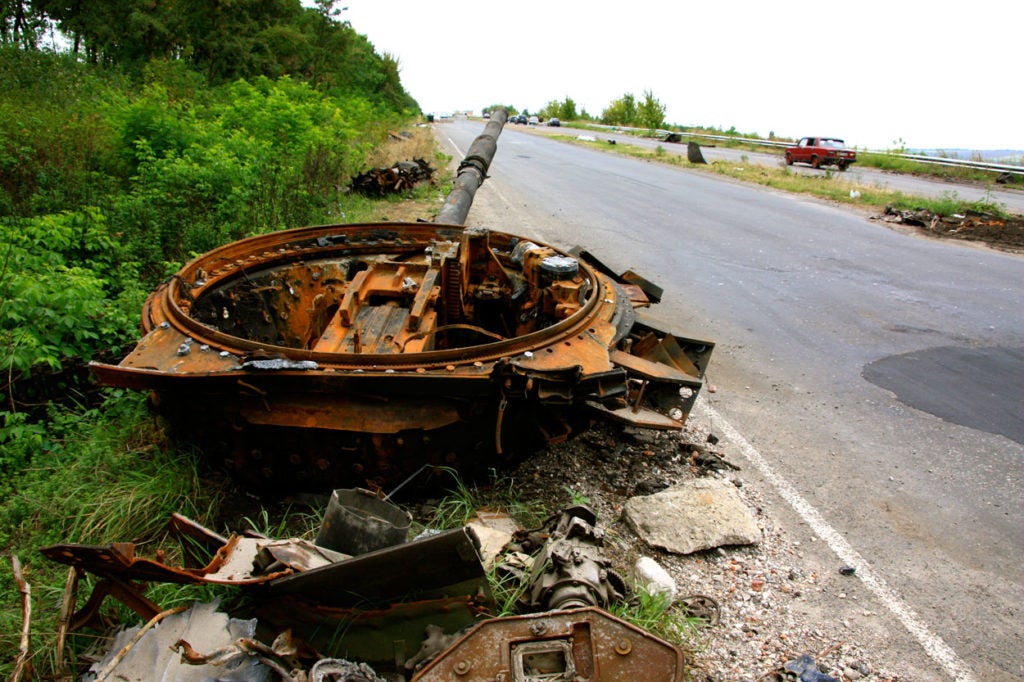
For its part, NATO is rotating military forces and holding exercises across Eastern Europe at levels unseen since the Cold War. Mutual distrust is increasing—and so is the danger of an accidental conflict as NATO and Russian forces interact more often and with more suspicion.
In 2014, the United States and the European Union levied punitive economic sanctions on Moscow for its aggression in Ukraine. Since then, relations between Russia and the West have hit a post-Cold War nadir.
Using cyberwarfare and an arsenal of weaponized propaganda, Russia has embarked on a hybrid war blitz against Western democracies. Looking back, it’s clear that Ukraine was the opening salvo of Russia’s ongoing war against the American-led, democratic world order.
As U.S. military forces in Europe repaint their desert tan equipment in forest green, there’s a feeling of deja vu among those few troops who can remember the Cold War.
Similarly, as the machine guns rattle and the artillery thunders across the plains of eastern Ukraine, one remembers that just two generations ago this land was the deadliest battlefield of the deadliest war in human history.
Today, the current war in Ukraine is nothing less than a sword of Damocles suspended over Eastern Europe, threatening to spark a larger conflagration.
When the sun goes down on this night, the tracers will cut across the dark sky up and down the front line. War-weary soldiers and civilians will hunker down in trenches and in cellars, staving off the cold and the fear as they have for more than five straight years.
There’s a 1 in 3 chance that a Ukrainian soldier will die tonight at the hands of a Russian weapon. There’s a good chance a civilian will be killed or wounded tonight, too.
The war goes on and on. When and where will it end?
Imagination
The war in Ukraine isn’t just the front line against Russian military aggression. It’s also the front line to defend the spirit and the promise of democracy. Ukrainian soldiers—like Daniel—are fighting our next war so we don’t have to.
“The thought that this has nothing to do with you or will never touch your interests will be fatal,” Zelenskyy, Ukraine’s president, said Wednesday at the U.N.
The American war correspondent Martha Gellhorn once wrote: “Unless they are immediate victims, the majority of mankind behaves as if war was an act of God which could not be prevented; or they behave as if war elsewhere was none of their business. It would be a bitter cosmic joke if we destroy ourselves due to atrophy of the imagination.”
It’s easy to believe that history automatically arcs in the right direction, or that the era of world wars is over. It could never happen again; not in our time, we mistakenly conclude.
But it sure doesn’t feel that way these days in Ukraine, or across Eastern Europe for that matter.
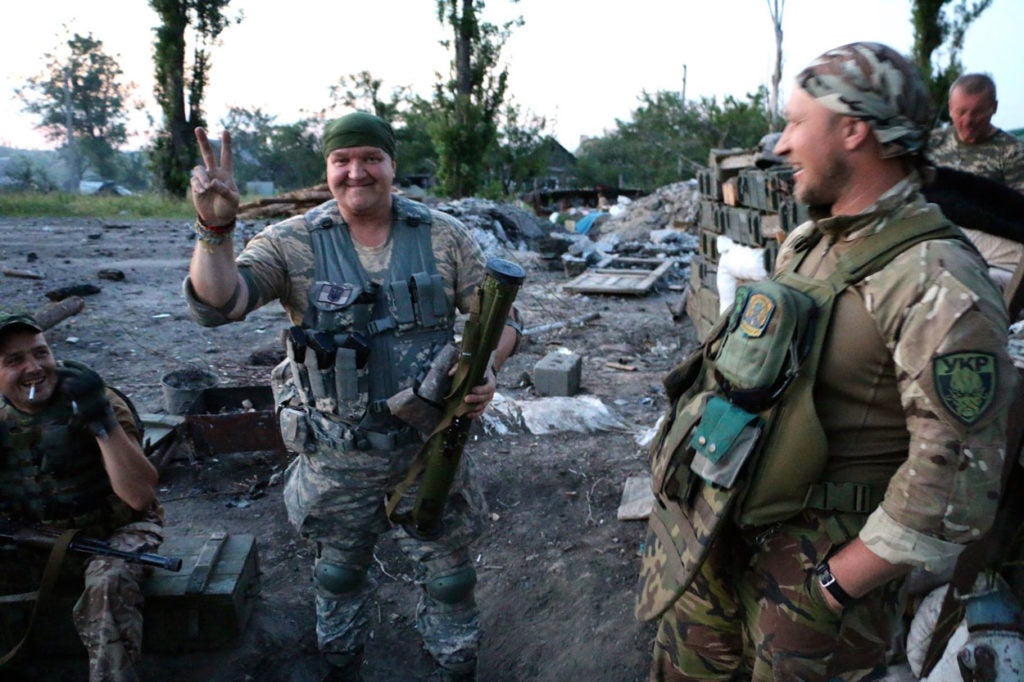
The truth is, we are just treading water, fighting against the gravitational tug of history. The minute we stop kicking, we descend, quickly and easily, into those dark depths from which we thought we had escaped. In the end, the only way to prevent the next world war from happening is to imagine that it could.
“We cannot think globally while turning a blind eye to small things, or as some may believe, to trifles,” Zelenskyy said at the U.N. “That is how the foundation of two world wars was laid down, and as a result, millions of human lives have paid the price for negligence, silence, inaction, or an unwillingness to relinquish our own ambitions.”
U.S. support for Ukraine, in any form—whether through diplomatic gestures or weapons—sends a signal to Ukrainian soldiers and civilians that they haven’t been forgotten, and that the democratic world order, which they want to be a part of so badly, is still worth fighting for.
These days, that’s a message the whole world needs to hear.
Ukraine, after all, is not the only battlefield on earth where a country’s democratic future, and the freedom of its people, hangs in the balance. The world is always watching how the U.S. reacts when its values are under attack. Always.
In his novel about the Spanish Civil War, “For Whom the Bell Tolls,” Ernest Hemingway wrote: “If we win here, we will win everywhere.”
I can’t think of a better way to explain why the war in Ukraine matters to the United States.































